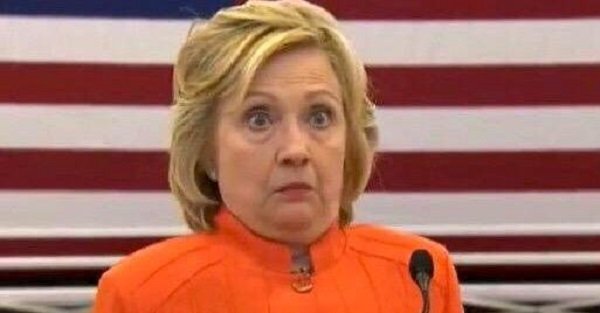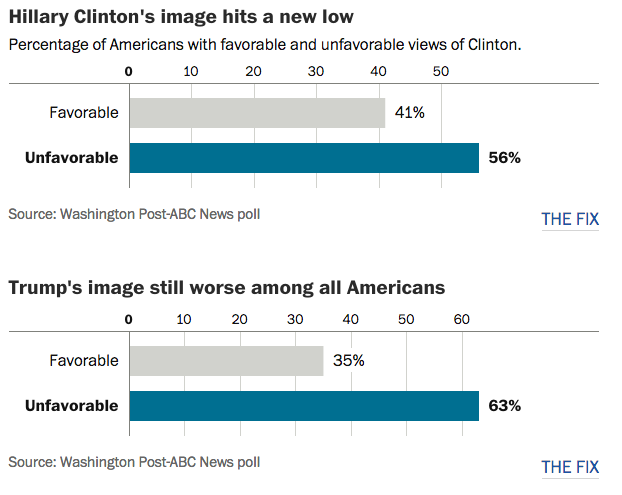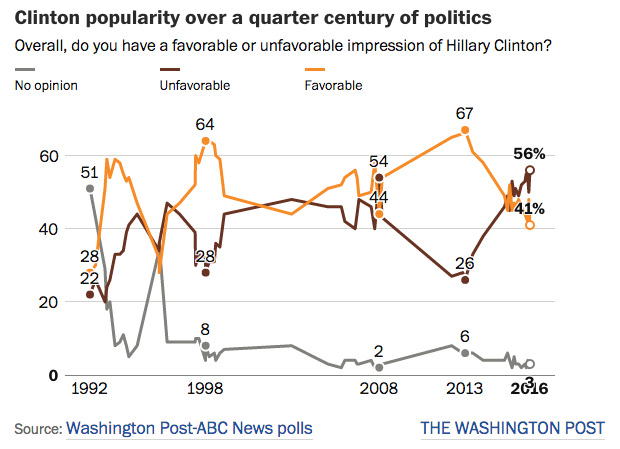As of today, though, Americans' views of her just hit a record low.
A new Washington Post-ABC News poll shows 41 percent of Americans have a favorable impression of Clinton, while 56 percent have an unfavorable one.
Comment: We wouldn't be surprised if it's actually much higher than 56 percent...
That's the worst image Clinton has had in her quarter-century in national public life. Her previous low favorable rating this year was in July, when it was 42 percent, lower than any mark in historical Post-ABC polls except a few points in the 1990s when a large share of the public had no opinion of her. Her previous high for unfavorable views was in June, when 55 percent disliked Clinton.
Trump, of course, has long been the more unpopular of the two presidential nominees, and he remains so; 35 percent of Americans have a favorable impression of him, compared to 63 percent unfavorable.
But if you look just at registered voters, the new poll actually shows Clinton's image is about as bad as Trump's, with 38 percent having a favorable impression and 59 percent unfavorable, compared to a 37/60 split for Trump.
Clinton's numbers serve as a reminder that Trump's unpopularity isn't prohibitive, largely because Americans -- and specifically registered voters -- don't much like Clinton either. If it weren't for Trump, in fact, Clinton would be the most unpopular major-party presidential nominee in modern American history.
Perhaps most notably, Clinton's image has declined significantly from just a month ago. After the Democratic convention, Americans were about evenly split -- 48 percent favorable and 50 percent unfavorable.
Interestingly, Clinton's numbers appear to have dropped since that early August poll mostly in groups that have been very supportive of her:
- Her favorable rating among women dropped from 54 percent to just 45 percent.
- Among Hispanics, it went from 71 percent to 55 percent.
- Among liberals, it went from 76 percent to 63 percent.
Comment: D'uh. A barrage of news has made it abundantly clear that Clinton is a corrupt, diseased, shrill little war harpy. No wonder her approval rate is plummeting.
But prior to that convention, it was clear that Clinton was headed in the wrong direction and setting new records for her unpopularity. As I wrote back then:
Clinton's favorable rating in the CNN poll is currently 16 points net-negative. That's unprecedented in the dozens of CNN polls on her since 1992.Clinton's image has been on a downward trajectory since her tenure as a highly popular secretary of state ended in 2013, and the decline continued through the primary campaign . That's largely been obscured by her lead in the horse race polls -- a lead that owes to Trump's inferior image and likely Clinton's advantages on her qualifications to serve as president.
Gallup's new numbers on Monday — 38 percent favorable and 57 percent unfavorable — are also unprecedented over the course of Clinton's political career.
This also appears to be the first time ever that Clinton's image measures worse than Trump's. It does so in both polls.
But Clinton is keeping this race competitive with her own personal problems. And right now, the voters who will determine the next president don't like her much more than they like Trump.
The Washington Post-ABC News poll was conducted August 24-28 among a random national sample of 1,020 adults, including users of both conventional and cellular phones. Results from the full survey have a margin of sampling error of plus or minus 3.5 percentage points. See interactive results by group and full trends over time and methodology. Scott Clement and Emily Guskin contributed to this post.







They don't want you to vote. That's the objective. That way they can appoint any clown as head of any government in the world, pillaging the masses under it.